132 15.3 Digestion and Absorption
Created by CK-12 Foundation/Adapted by Christine Miller

Competitive Eating
This man is on his way to coming in third in an international hot dog eating contest (Figure 15.3.1). It may look as though he is regurgitating his hot dogs, but in fact, he is trying to get them into his mouth and down his throat as quickly as he can. In order to eat as many hot dogs as possible in the allotted time, he pushes several into his mouth at once, and doesn’t bother doing much chewing. Chewing is normally the first step in the process of digestion.
Digestion
Digestion of food is a form of catabolism, in which the food is broken down into small molecules that the body can absorb and use for energy, growth, and repair. Digestion occurs when food is moved through the digestive system. This process begins in the mouth and ends in the small intestine. The final products of digestion are absorbed from the digestive tract, primarily in the small intestine. There are two different types of digestion that occur in the digestive system: mechanical digestion and chemical digestion. Figure 15.3.2 summarizes the roles played by different digestive organs in mechanical and chemical digestion, both of which are described in detail below.
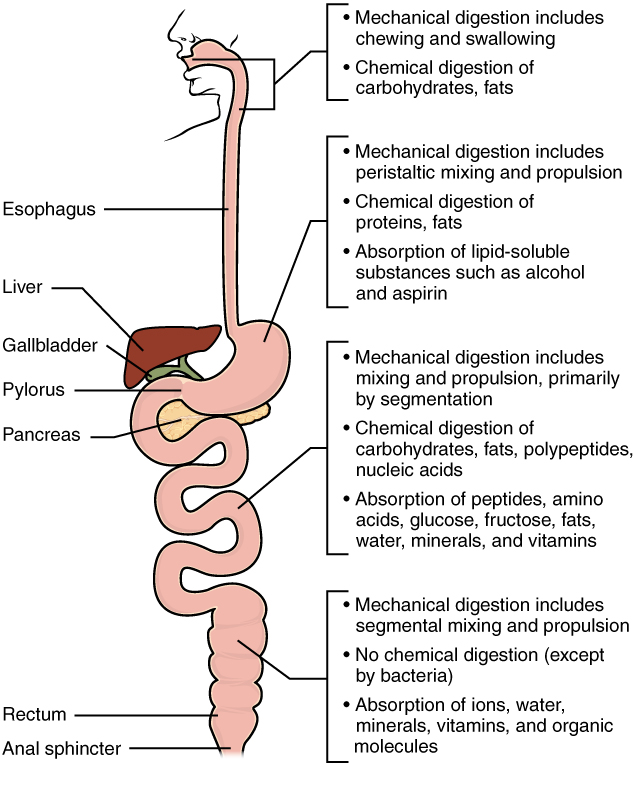
Mechanical Digestion

Mechanical digestion is a physical process in which food is broken into smaller pieces without becoming changed chemically. It begins with your first bite of food (see Figure 15.3.3) and continues as you chew food with your teeth into smaller pieces. The process of mechanical digestion continues in the stomach. This muscular organ churns and mixes the food it contains, an action that breaks any solid food into still smaller pieces.
Although some mechanical digestion also occurs in the small intestine, it is mostly completed by the time food leaves the stomach. At that stage, food in the GI tract has been changed to the thick semi-fluid called chyme. Mechanical digestion is necessary so that chemical digestion can be effective. Mechanical digestion tremendously increases the surface area of food particles so they can be acted upon more effectively by digestive enzymes.
Chemical Digestion
Chemical digestion is the biochemical process in which macromolecules in food are changed into smaller molecules that can be absorbed into body fluids and transported to cells throughout the body. Substances in food that must be chemically digested include carbohydrates, proteins, lipids, and nucleic acids. Carbohydrates must be broken down into simple sugars, proteins into amino acids, lipids into fatty acids and glycerol, and nucleic acids into nitrogen bases and sugars. Some chemical digestion takes place in the mouth and stomach, but most of it occurs in the first part of the small intestine (duodenum).
Digestive Enzymes
Chemical digestion could not occur without the help of many different digestive enzymes. Enzymes are proteins that catalyze, or speed up, biochemical reactions. Digestive enzymes are secreted by exocrine glands or by the mucosal layer of epithelium lining the gastrointestinal tract. In the mouth, digestive enzymes are secreted by salivary glands. The lining of the stomach secretes enzymes, as does the lining of the small intestine. Many more digestive enzymes are secreted by exocrine cells in the pancreas and carried by ducts to the small intestine. The following table lists several important digestive enzymes, the organs and/or glands that secrete them, the compounds they digest, and the pH necessary for optimal functioning. You can read more about them below.
| Digestive Enzyme | Source Organ | Site of Action | Reactant and Product | Optimal pH |
|---|---|---|---|---|
| Salivary Amylase | Salivary Glands | Mouth | starch + water ⇒ maltose | Neutral |
| Pepsin | Stomach | Stomach | protein + water ⇒ peptides | Acidic |
| Pancreatic Amylase | Pancreas | Duodenum | starch + water ⇒ maltose | Basic |
| Maltase | Small intestine | Small intestine | maltose + water ⇒ glucose | Basic |
| Sucrase | Small intestine | Small intestine | sucrose + water ⇒ glucose + fructose | Basic |
| Lactase | Small intestine | Small intestine | lactose + water ⇒ glucose + galactose | Basic |
| Lipase | Pancreas | Duodenum | fat droplet and water ⇒ glycerol and fatty acids | Basic |
| Trypsin | Pancreas | Duodenum | protein + water ⇒ peptides | Basic |
| Chymotrypsin | Pancreas | Duodenum | protein + water ⇒ peptides | Basic |
| Peptidases | Small intestine | Small intestine | peptides + water ⇒ | Basic |
| Deoxyribonuclease | Pancreas | Duodenum | DNA + water ⇒ nucleotide fragments | Basic |
| Ribonuclease | Pancreas | Duodenum | RNA + water ⇒ nucleotide fragments | Basic |
| Nuclease | Small intestine | Small intestine | nucleic acids + water ⇒ nucleotide fragments | Basic |
| Nucleosidases | Small intestine | Small intestine | nucleotides + water ⇒ nitrogen base + phosphate sugar | Basic |
Chemical Digestion of Carbohydrates
About 80% of digestible carbohydrates in a typical Western diet are in the form of the plant polysaccharide amylose, which consists mainly of long chains of glucose and is one of two major components of starch. Additional dietary carbohydrates include the animal polysaccharide glycogen, along with some sugars, which are mainly disaccharides.
The process of chemical digestion for some carbohydrates is illustrated Figure 15.3.4. To chemically digest amylose and glycogen, the enzyme amylase is required. The chemical digestion of these polysaccharides begins in the mouth, aided by amylase in saliva. Saliva also contains mucus — which lubricates the food — and hydrogen carbonate, which provides the ideal alkaline conditions for amylase to work. Carbohydrate digestion is completed in the small intestine, with the help of amylase secreted by the pancreas. In the digestive process, polysaccharides are reduced in length by the breaking of bonds between glucose monomers. The macromolecules are broken down to shorter polysaccharides and disaccharides, resulting in progressively shorter chains of glucose. The end result is molecules of the simple sugars glucose and maltose (which consists of two glucose molecules), both of which can be absorbed by the small intestine.
Other sugars are digested with the help of different enzymes produced by the small intestine. Sucrose (or table sugar), for example, is a disaccharide that is broken down by the enzyme sucrase to form glucose and fructose, which are readily absorbed by the small intestine. Digestion of the sugar lactose, which is found in milk, requires the enzyme lactase, which breaks down lactose into glucose and galactose. Glucose and galactose are then absorbed by the small intestine. Fewer than half of all adults produce sufficient lactase to be able to digest lactose. Those who cannot are said to be lactose intolerant.
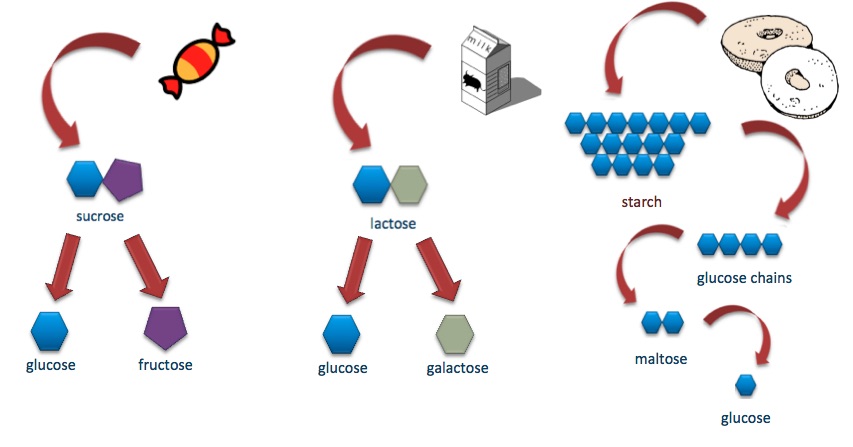
Chemical Digestion of Proteins
Proteins consist of polypeptides, which must be broken down into their constituent amino acids before they can be absorbed. An overview of this process is shown in Figure 15.3.5. Protein digestion occurs in the stomach and small intestine through the action of three primary enzymes: pepsin (secreted by the stomach), and trypsin and chymotrypsin (secreted by the pancreas). The stomach also secretes hydrochloric acid (HCl), making the contents highly acidic, which is a required condition for pepsin to work. Trypsin and chymotrypsin in the small intestine require an alkaline (basic) environment to work. Bile from the liver and bicarbonate from the pancreas neutralize the acidic chyme as it empties into the small intestine. After pepsin, trypsin, and chymotrypsin break down proteins into peptides, these are further broken down into amino acids by other enzymes called peptidases, also secreted by the pancreas.
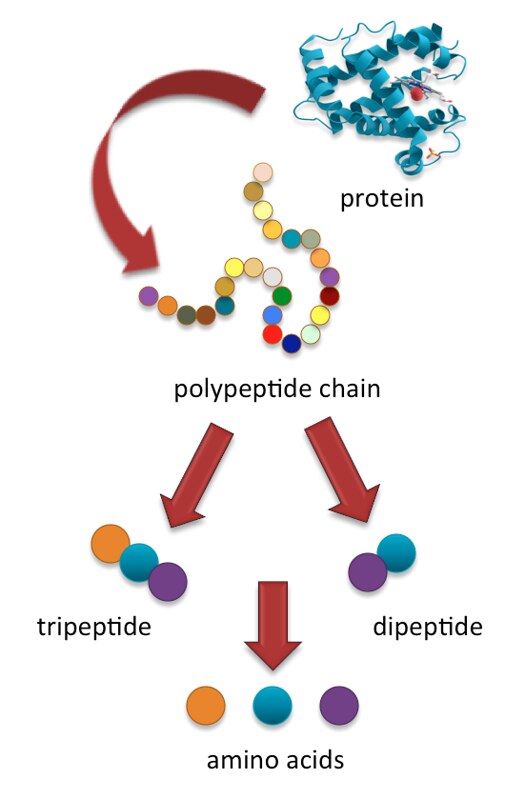
Chemical Digestion of Lipids
The chemical digestion of lipids begins in the mouth. The salivary glands secrete the digestive enzyme lipase, which breaks down short-chain lipids into molecules consisting of two fatty acids. A tiny amount of lipid digestion may take place in the stomach, but most lipid digestion occurs in the small intestine.
Digestion of lipids in the small intestine occurs with the help of another lipase enzyme from the pancreas, as well as bile secreted by the liver. As shown in the diagram below (Figure 15.3.6), bile is required for the digestion of lipids, because lipids are oily and do not dissolve in the watery chyme. Bile emulsifies (or breaks up) large globules of food lipids into much smaller ones, called micelles, much as dish detergent breaks up grease. The micelles provide a great deal more surface area to be acted upon by lipase, and also point the hydrophilic (“water-loving”) heads of the fatty acids outward into the watery chyme. Lipase can then access and break down the micelles into individual fatty acid molecules.
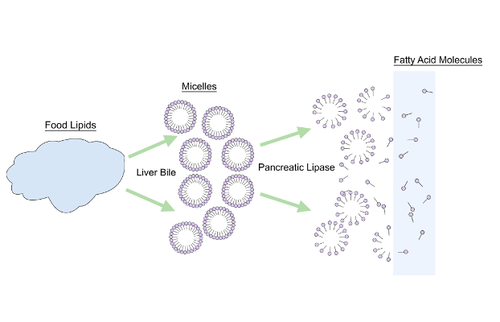
Chemical Digestion of Nucleic Acids
Nucleic acids (DNA and RNA) in foods are digested in the small intestine with the help of both pancreatic enzymes and enzymes produced by the small intestine itself. Pancreatic enzymes called ribonuclease and deoxyribonuclease break down RNA and DNA, respectively, into smaller nucleic acids. These, in turn, are further broken down into nitrogen bases and sugars by small intestine enzymes called nucleases.
Bacteria in the Digestive System
Your large intestine is not just made up of cells. It is also an ecosystem, home to trillions of bacteria known as the “gut flora” (Figure 15.3.7). But don’t worry, most of these bacteria are helpful. Friendly bacteria live mostly in the large intestine and part of the small intestine. The acidic environment of the stomach does not allow bacterial growth.
Gut bacteria have several roles in the body. For example, intestinal bacteria:
- Produce vitamin B12 and vitamin K.
- Control the growth of harmful bacteria.
- Break down poisons in the large intestine.
- Break down some substances in food that cannot be digested, such as fibre and some starches and sugars. Bacteria produce enzymes that digest carbohydrates in plant cell walls. Most of the nutritional value of plant material would be wasted without these bacteria. These help us digest plant foods like spinach.
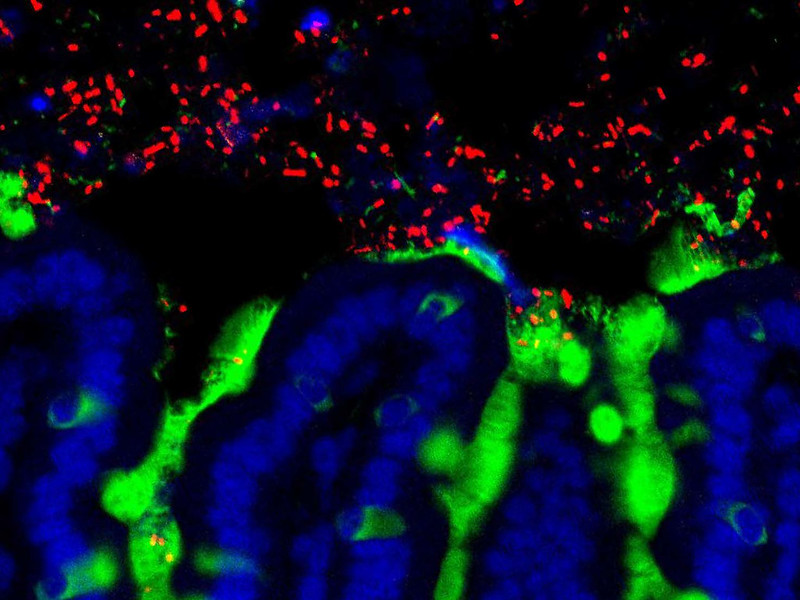
A wide range of friendly bacteria live in the gut. Bacteria begin to populate the human digestive system right after birth. Gut bacteria include Lactobacillus, the bacteria commonly used in probiotic foods such as yogurt, and E. coli bacteria. About a third of all bacteria in the gut are members of the Bacteroides species. Bacteroides are key in helping us digest plant food.
It is estimated that 100 trillion bacteria live in the gut. This is more than the human cells that make up you. It has also been estimated that there are more bacteria in your mouth than people on the planet — there are over 7 billion people on the planet!
The bacteria in your digestive system are from anywhere between 300 and 1,000 species. As these bacteria are helpful, your body does not attack them. They actually appear to the body’s immune system as cells of the digestive system, not foreign invaders. The bacteria actually cover themselves with sugar molecules removed from the actual cells of the digestive system. This disguises the bacteria and protects them from the immune system.
As the bacteria that live in the human gut are beneficial to us, and as the bacteria enjoy a safe environment to live, the relationship that we have with these tiny organisms is described as mutualism, a type of symbiotic relationship.
Lastly, keep in mind the small size of bacteria. Together, all the bacteria in your gut may weigh just about two pounds.
Control of the Digestive Process
The process of digestion is controlled by both hormones and nerves. Hormonal control is mainly by endocrine hormones secreted by cells in the lining of the stomach and small intestine. These hormones stimulate the production of digestive enzymes, bicarbonate, and bile. The hormone secretin, for example, is produced by endocrine cells lining the duodenum of the small intestine. Acidic chyme entering the duodenum from the stomach triggers the release of secretin into the bloodstream. When the secretin returns via the circulation to the digestive system, it signals the release of bicarbonate from the pancreas. The bicarbonate neutralizes the acidic chyme. See Table 15.3.2 for a summary of the major hormones governing the process of chemical digestion.
| Hormone | Source Organ | Target Organ | Trigger | Result |
|---|---|---|---|---|
| Gastrin | Stomach walls | Stomach | High protein intake | HCL and pepsin release, stomach churning |
| Secretin | Duodenum | Pancreas
Gallbladder |
Acidic chyme entering the duodenum | Release sodium bicarbonate, release bile |
| Cholecystokinin (CCK) | Duodenum | Pancreas
Gallbladder |
Partially digested fat and protein in duodenum | Release lipase, trypsin, release bile |
Nerves involved in digestion include those that connect digestive organs to the central nervous system, as well as nerves inside the walls of the digestive organs. Nerves connecting the digestive organs to the central nervous system cause smooth muscles in the walls of digestive organs to contract or relax as needed, depending on whether or not there is food to be digested. Nerves within digestive organs are stimulated when food enters the organs and stretches their walls. These nerves trigger the release of substances that speed up or slow down the movement of food through the GI tract and the secretion of digestive enzymes.
Absorption
When digestion is finished, it results in many simple nutrient molecules that must go through the process of absorption from the lumen of the GI tract to blood or lymph vessels, so they can be transported to and used by cells throughout the body. A few substances are absorbed in the stomach and large intestine. Water is absorbed in both of these organs, and some minerals and vitamins are also absorbed in the large intestine, but about 95% of nutrient molecules are absorbed in the small intestine. Absorption of the majority of these molecules takes place in the second part of the small intestine, called the jejunum. There are, however, a few exceptions — for example, iron is absorbed in the duodenum, and vitamin B12 is absorbed in the last part of the small intestine, called the ileum. After being absorbed in the small intestine, nutrient molecules are transported to other parts of the body for storage or further chemical modification. Amino acids, for instance, are transported to the liver to be used for protein synthesis.
The epithelial tissue lining the small intestine is specialized for absorption. It is highly enfolded and is covered with villi and microvilli, creating an enormous surface area for absorption. As shown in Figure 15.3.8, each villus also has a network of blood capillaries and fine lymphatic vessels called lacteals close to its surface. The thin surface layer of epithelial cells of the villi transports nutrients from the lumen of the small intestine into these capillaries and lacteals. Blood in the capillaries absorbs most of the molecules, including simple sugars, amino acids, glycerol, salts, and water-soluble vitamins (vitamin C and the many B vitamins). Lymph in the lacteals absorbs fatty acids and fat-soluble vitamins (vitamins A, D, E, and K).
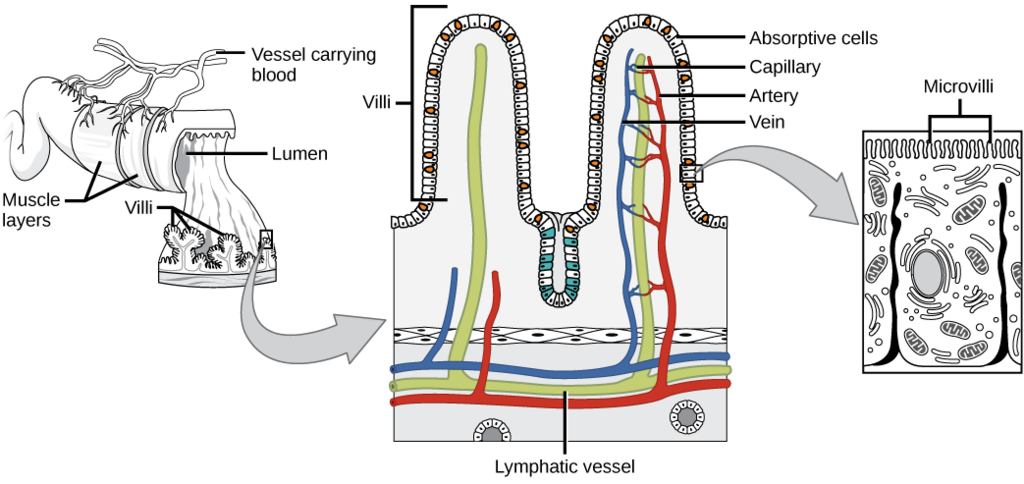
Feature: My Human Body
The process of digestion does not always go as it should. Many people suffer from indigestion, or dyspepsia, a condition of impaired digestion. Symptoms may include upper abdominal fullness or pain, heartburn, nausea, belching, or some combination of these symptoms. The majority of cases of indigestion occur without evidence of an organic disease that is likely to explain the symptoms. Anxiety or certain foods or medications (such as aspirin) may be contributing factors in these cases. In other cases, indigestion is a symptom of an organic disease, most often gastroesophageal reflux disease (GERD) or gastritis. In a small minority of cases, indigestion is a symptom of a peptic ulcer of the stomach or duodenum, usually caused by a bacterial infection. Very rarely, indigestion is a sign of cancer.
An occasional bout of indigestion is usually nothing to worry about, especially in people less than 55 years of age. However, if you suffer frequent or chronic indigestion, it’s a good idea to see a doctor. If an underlying disorder such as GERD or an ulcer is causing the indigestion, this can and should be treated. If no organic disease is discovered, the doctor can recommend lifestyle changes or treatments to help prevent or soothe the symptoms of acute indigestion. Lifestyle changes might include modifications in eating habits, such as eating more slowly, eating smaller meals, or avoiding fatty foods. You also might be advised to refrain from taking certain medications, especially on an empty stomach. The use of antacids or other medications to relieve symptoms may also be recommended.
15.3 Summary
- Digestion is a form of catabolism, in which food is broken down into small molecules that the body can absorb and use for energy, growth, and repair. Digestion occurs when food moves through the gastrointestinal (GI) tract. The digestive process is controlled by both hormones and nerves.
- Mechanical digestion is a physical process in which food is broken into smaller pieces without becoming chemically changed. It occurs mainly in the mouth and stomach.
- Chemical digestion is a chemical process in which macromolecules — including carbohydrates, proteins, lipids, and nucleic acids — in food are changed into simple nutrient molecules that can be absorbed into body fluids. Carbohydrates are chemically digested to sugars, proteins to amino acids, lipids to fatty acids, and nucleic acids to individual nucleotides. Chemical digestion requires digestive enzymes. Gut flora carry out additional chemical digestion.
- Absorption occurs when the simple nutrient molecules that result from digestion are absorbed into blood or lymph.
15.3 Review Questions
- Define digestion. Where does it occur?
-
- Identify two organ systems that control the process of digestion by the digestive system.
- What is mechanical digestion? Where does it occur?
- Describe chemical digestion.
- What is the role of enzymes in chemical digestion?
- What is absorption? When does it occur?
- Where does most absorption occur in the digestive system? Why does most of the absorption occur in this organ, and not earlier in the GI tract?
15.3 Explore More
Food for thought: How your belly controls your brain | Ruairi Robertson | TEDxFulbrightSantaMonica, TEDx Talks, 2015.
How the food you eat affects your gut – Shilpa Ravella, TED-Ed, 2017.
What causes heartburn? – Rusha Modi, TED-Ed, 2018.
Attributions
Figure 15.3.1
Patrick_Bertoletti_eating_hot_dogs by Michael on Wikimedia Commons is used under a CC BY 2.0 (https://creativecommons.org/licenses/by/2.0) license.
Figure 15.3.2
2426_Mechanical_and_Chemical_DigestionN by OpenStax College on Wikimedia Commons is used under a CC BY 3.0 (https://creativecommons.org/licenses/by/3.0) license.
Figure 15.3.3
Eating tacos [photo] by DeMorris Byrd on Unsplash is used under the Unsplash License (https://unsplash.com/license).
Figure 15.3.4
Carbohydrate digestion by Nutritional Doublethink on Flickr is used under a CC BY-SA 2.0 (https://creativecommons.org/licenses/by-sa/2.0/) license.
Figure 15.3.5
Peptide Digestion by Nutritional Doublethink on Flickr is used under a CC BY 2.0 (https://creativecommons.org/licenses/by/2.0/) license.
Figure 15.3.6
Bile from the liver and lipase from the pancreas help digest lipids in small intestine by CK-12 Foundation is used under a CC BY NC 3.0 (https://creativecommons.org/licenses/by-nc/3.0/) license.
Figure 15.3.7
Gut Flora by NIH Image Gallery on Flickr by NIH Image Gallery on Flickr is used under a CC BY-NC-SA 2.0 (https://creativecommons.org/licenses/by-nc-sa/2.0/) license.
Figure 15.3.8
Figure_34_01_11f by CNX OpenStax on Wikimedia Commons is used under a CC BY 4.0 (https://creativecommons.org/licenses/by/4.0) license.
References
Betts, J. G., Young, K.A., Wise, J.A., Johnson, E., Poe, B., Kruse, D.H., Korol, O., Johnson, J.E., Womble, M., DeSaix, P. (2013, June 19). Figure 23.28 Digestion and absorption [digital image]. In Anatomy and Physiology (Section 23.7). OpenStax. https://openstax.org/books/anatomy-and-physiology/pages/23-7-chemical-digestion-and-absorption-a-closer-look
Brainard, J/ CK-12 Foundation. (2016). Figure 6 Both bile from the liver and lipase from the pancreas help digest lipids in the small intestine [digital image]. In CK-12 College Human Biology (Section 17.3) [online Flexbook]. CK12.org. https://www.ck12.org/book/ck-12-college-human-biology/section/17.3/
OpenStax. (2016, May 27) Figure 11 Villi are folds on the small intestine lining that increase the surface area to facilitate the absorption of nutrients. [digital image]. In OpenStax, Biology (Section 34.1). OpenStax CNX. https://cnx.org/contents/GFy_h8cu@10.53:Oestf0YE@6/Digestive-Systems
TED-Ed. (2017, March 23). How the food you eat affects your gut – Shilpa Ravella. YouTube. https://www.youtube.com/watch?v=1sISguPDlhY&feature=youtu.be
TED-Ed. (2018, November 1). What causes heartburn? – Rusha Modi. YouTube. https://www.youtube.com/watch?v=jP-9AD0wMOk&feature=youtu.be
TEDx Talks. (2015, December 7). Food for thought: How your belly controls your brain | Ruairi Robertson | TEDxFulbrightSantaMonica. YouTube. https://www.youtube.com/watch?v=awtmTJW9ic8&feature=youtu.be
The process of breaking down food into nutrients that can be absorbed by blood or lymph.
The breakdown of larger molecules into smaller ones.
The opening in the lower part of the human face, surrounded by the lips, through which food is taken in and from which speech and other sounds are emitted.
A long, narrow, tube-like organ of the digestive system where most chemical digestion of food and virtually all absorption of nutrients take place.
The physical breakdown of chunks of food into smaller pieces by organs of the digestive system, for example chewing food.
Chemical breakdown of large, complex food molecules into smaller, simpler nutrient molecules that can be absorbed by blood or lymph. Usually involves a digestive enzyme.
A thick, semi-liquid mixture that food in the gastrointestinal tract becomes by the time it leaves the stomach.
The measure of how much exposed area a solid object has, expressed in square units.
A very large molecule, such as protein, commonly created by the polymerization of smaller subunits (monomers).
A biomolecule consisting of carbon (C), hydrogen (H) and oxygen (O) atoms, usually with a hydrogen–oxygen atom ratio of 2:1. Complex carbohydrates are polymers made from monomers of simple carbohydrates, also termed monosaccharides.
A class of biological molecule consisting of linked monomers of amino acids and which are the most versatile macromolecules in living systems and serve crucial functions in essentially all biological processes.
A substance that is insoluble in water. Examples include fats, oils and cholesterol. Lipids are made from monomers such as glycerol and fatty acids.
A complex organic substance present in living cells, especially DNA or RNA, whose molecules consist of many nucleotides linked in a long chain.
The generic name for sweet-tasting, soluble carbohydrates, many of which are used in food. The various types of sugar are derived from different sources. Simple sugars are called monosaccharides and include glucose, fructose, and galactose.
Amino acids are organic compounds that combine to form proteins.
Long chains of hydrocarbons with a carboxyl group and a methyl group at opposite ends. Can be either saturated, containing mostly single bonds between adjacent carbons, or unsaturated, containing many double bonds between adjacent carbons.
The first and shortest of three parts of the small intestine where most chemical digestion occurs.
Biological molecules that lower amount the energy required for a reaction to occur.
Gland such as a sweat gland, salivary gland, or mammary gland that secretes a substance into a duct that carries the secretion to the outside of the body.
The innermost tunic of the wall. It lines the lumen of the digestive tract. The mucosa consists of epithelium, an underlying loose connective tissue layer called lamina propria, and a thin layer of smooth muscle called the muscularis mucosa.
One of many exocrine glands in the mouth that secrete saliva into the mouth through ducts.
A sac-like organ of the digestive system between the esophagus and small intestine in which both mechanical and chemical digestion take place.
A long, flat gland that sits tucked behind the stomach in the upper abdomen. The pancreas produces enzymes that help digestion and hormones that help regulate the way your body processes sugar (glucose).
Polysaccharides are carbohydrate molecules composed of long chains of monosaccharide units bound together. They range in structure from linear to highly branched.
Glucose (also called dextrose) is a simple sugar with the molecular formula C6H12O6. Glucose is the most abundant monosaccharide, a subcategory of carbohydrates. Glucose is mainly made by plants and most algae during photosynthesis from water and carbon dioxide, using energy from sunlight.
A stored form of glucose used by plants.
A multi-branched polysaccharide of glucose that serves as a form of energy storage in animals, fungi, and bacteria.
The sugar formed when two monosaccharides are joined by glycosidic linkage.
An enzyme, found chiefly in saliva and pancreatic fluid, that converts starch and glycogen into simple sugars.
A fluid secreted by salivary glands that keeps the mouth moist and contains the digestive enzymes amylase and lipase.
The part of each hemisphere of the cerebrum that is involved in functions such as touch, reading, and arithmetic.
The chief digestive enzyme in the stomach, which breaks down proteins into polypeptides.
A digestive enzyme that breaks down proteins in the small intestine. It is secreted by the pancreas in an inactive form, trypsinogen.
A digestive enzyme which breaks down proteins in the small intestine. It is secreted by the pancreas and converted into an active form by trypsin.
Fluid produced by the liver and stored in the gall bladder that is secreted into the small intestine to help digest lipids and neutralize acid from the stomach.
An organ of digestion and excretion that secretes bile for lipid digestion and breaks down excess amino acids and toxins in the blood.
An enzyme which breaks down peptides into amino acids.
A pancreatic enzyme that catalyzes the breakdown of fats to fatty acids and glycerol.
A community of livings things interrelated with their physical and chemical environment.
The body system which acts as a chemical messenger system comprising feedback loops of the hormones released by internal glands of an organism directly into the circulatory system, regulating distant target organs. In humans, the major endocrine glands are the thyroid gland and the adrenal glands.
One of two main divisions of the nervous system that includes the brain and spinal cord.
Process in which substances such as nutrients pass into the blood or lymph.
A body fluid in humans and other animals that delivers necessary substances such as nutrients and oxygen to the cells and transports metabolic waste products away from those same cells. In vertebrates, it is composed of blood cells suspended in blood plasma.
A fluid that leaks out of capillaries into spaces between cells and circulates in the vessels of the lymphatic system.
An organ of the digestive system that removes water and salts from food waste and forms solid feces for elimination.
One of three sections that make up the small intestine. The jejunum is located between the duodenum and the ileum.The jejunum makes up about two-fifths of the small intestine. The main function of the jejunum is absorption of important nutrients such as sugars, fatty acids, and amino acids.
The third portion of the small intestine, between the jejunum and the cecum.The ileum helps to further digest food coming from the stomach and other parts of the small intestine.
A microscopic, finger-like projections in a mucous membrane that form a large surface area for absorption.
One of many tiny projections covering each villus in the mucosal lining the small intestine that increases its absorptive surface.
The smallest type of blood vessel that connects arterioles and venules and that transfers substances between blood and tissues.
A lymphatic capillary that absorbs dietary fats in the villi of the small intestine.


